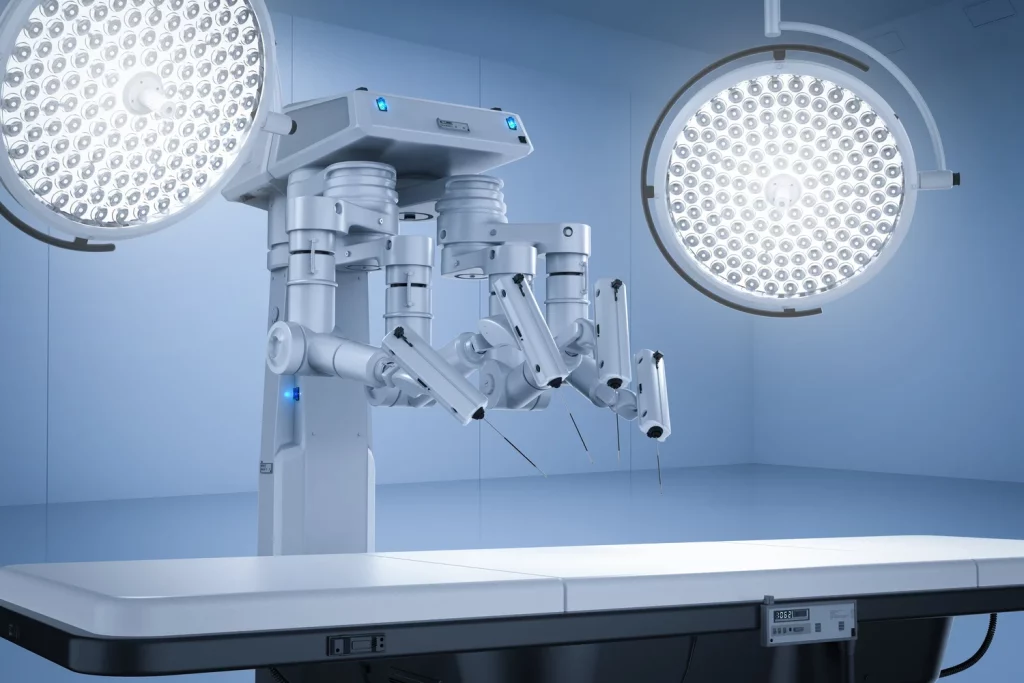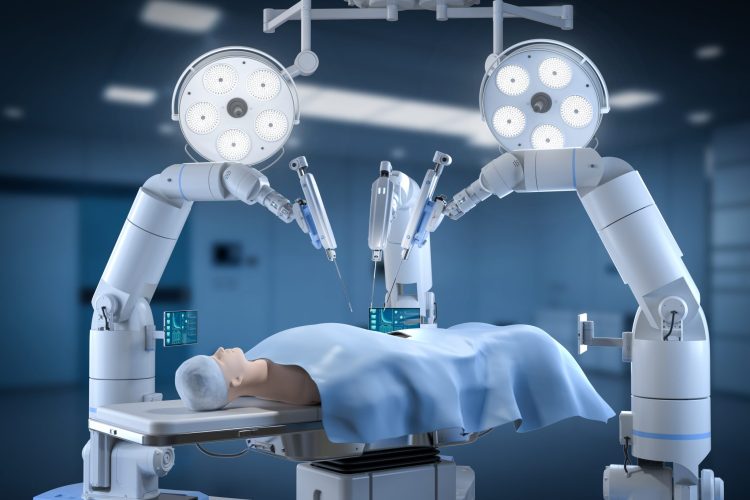1. Introduction
In the past, surgical procedures were primarily performed by human hands, guided by years of experience, intuition, and skill. However, as medical science advanced, so did the technology that supports surgery. The introduction of robotic surgery has opened new possibilities for achieving greater precision, speed, and recovery times. Among these advances, biomimetic robots, which replicate the movements, dexterity, and adaptability of living organisms, have become a promising area of development.
Biomimetic robots are designed to imitate the mechanisms of biological organisms in order to perform tasks with high efficiency and precision. These robots are often made of soft materials and incorporate movement patterns that replicate biological structures, such as animal limbs, human-like hands, and even self-healing capabilities. In the field of surgery, these robots can offer superior dexterity, flexibility, and force control, making them ideal for delicate and intricate procedures.
This article explores the role of biomimetic robots in surgery, detailing how these robots enhance surgical precision, minimize tissue damage, and contribute to better patient outcomes. We will also look at the current challenges in this technology, its applications, and its potential future.
2. Biomimetic Design Principles in Robotic Surgery
2.1 Mimicking Biological Movements for Precision
The core principle behind biomimetic robotics is to emulate the complex and refined movements of biological organisms. For instance, a robot designed to mimic the human hand will be capable of delicate movements and control over force. The precision of a human hand is unparalleled, especially in fine motor tasks, and biomimetic robots aim to replicate this dexterity.
One of the most notable examples of this is the da Vinci Surgical System, a robotic platform that allows surgeons to perform minimally invasive surgeries with enhanced precision. The system features robotic arms that can move with the agility of human hands but with far greater accuracy. These arms can mimic natural hand movements, even at a scale smaller than what is possible with human hands alone. This ability to perform complex maneuvers, such as suturing and tissue manipulation, has revolutionized procedures like prostatectomies and gynecological surgeries.
Another example of biomimetic design is soft robotics, which focuses on flexible, deformable robots that can replicate the movements of octopus limbs or bird wings. This flexibility allows robots to navigate confined or delicate spaces in the human body, such as blood vessels or the gastrointestinal tract, without causing harm to surrounding tissues.
2.2 Soft Robotics for Minimally Invasive Surgery
Soft robots are one of the most promising areas of biomimetic surgery. By mimicking the flexibility and adaptability of biological tissues, soft robots can perform delicate tasks with greater safety and efficiency. Soft robots can be made of materials that bend, stretch, and compress, giving them the ability to access spaces that rigid robots or human hands cannot.
For instance, robots inspired by the octopus—known for its ability to squeeze through tight spaces and manipulate objects with precision—are particularly useful in minimally invasive surgeries. These soft robotic arms can wrap around organs or tissues, gently performing operations such as tissue extraction or incision without applying excessive pressure.
2.3 Precision Force Control through Biomimicry
Biomimetic robots can also replicate the force control exhibited by living organisms. The ability to control force is crucial in surgical procedures where excessive pressure can lead to tissue damage or complications. By mimicking biological structures like the human hand or tentacles, biomimetic robots are capable of applying just the right amount of force needed to manipulate tissues and organs safely.
For example, robots designed to replicate the fingers of a surgeon can use specialized sensors to adjust the amount of force applied during tissue manipulation, ensuring minimal disruption and reducing the risk of intraoperative complications. This force feedback capability enhances the surgeon’s ability to perform complex tasks with extreme accuracy.

3. Applications of Biomimetic Robots in Surgery
3.1 Minimally Invasive Surgeries
Minimally invasive surgery (MIS) has transformed the medical field by enabling procedures to be performed with smaller incisions, reducing pain, recovery times, and the risk of infection. Biomimetic robots are particularly useful in these types of surgeries, as they can operate in tight spaces with more precision and less damage to surrounding tissue.
For instance, the da Vinci Surgical System allows surgeons to perform procedures like heart valve repair, prostate removal, and organ biopsies with tiny incisions, all while ensuring greater precision. The robot’s ability to mimic human hand movements in three-dimensional space enhances the surgeon’s control and allows for complex motions that are impossible with traditional tools.
Another example is soft robotic endoscopes, which can navigate through the human body with greater ease. These robots can access areas that are hard to reach using conventional rigid tools, such as the spinal column or blood vessels, and are used in minimally invasive diagnostic procedures.
3.2 Robotic-Assisted Surgery for Delicate Tasks
Certain surgeries, such as neurosurgery, ophthalmic procedures, and microsurgery, require the utmost precision and dexterity. Biomimetic robots, due to their flexible nature and force-sensitive control, are ideal for such delicate tasks.
Robotic arms, for example, can be employed in neurosurgery to access the brain through a small opening, removing tumors, clots, or performing electrode implantations for patients with Parkinson’s disease. The fine motor control and the ability to apply precise force enable surgeons to manipulate delicate tissues without causing unnecessary damage.
Similarly, biomimetic robots inspired by the movement of insect appendages can be used in ophthalmic surgery, where the robot can delicately handle the eye and perform tasks like cataract removal or retinal repair with exceptional care.
3.3 Robotic Rehabilitation and Assistance
In addition to performing surgeries, biomimetic robots also play an essential role in post-surgical recovery and rehabilitation. Soft robots modeled after human limbs can be used to help patients recover mobility and strength after injuries or surgeries. These robots can move in ways that mimic natural limb motions, providing therapy that is more aligned with the body’s natural movement.
The Rehabilitation Robot (RR) systems use biomimetic design to offer gentle, controlled movements to assist patients in regaining motor function. The robots can adapt to the patient’s needs, customizing movements based on the individual’s progress, which enhances the efficiency and effectiveness of rehabilitation.
4. Challenges and Limitations in Biomimetic Surgical Robotics
4.1 Material Constraints
Despite the tremendous potential of soft robotics, the materials used to replicate biological structures still present challenges. Many soft materials used in robotics, such as elastomers and polymers, face limitations in terms of durability, strength, and biocompatibility. Ensuring that these materials can withstand the stresses of repeated surgical procedures while maintaining precision and flexibility is a key research area.
4.2 Energy Efficiency
Biomimetic robots often rely on sophisticated actuators and sensors to achieve the delicate movements required in surgery. However, these systems tend to be power-hungry, and battery life remains a challenge, especially for robots involved in long-duration operations. Future advancements must focus on energy-efficient designs that provide sustained operation without sacrificing performance.
4.3 Autonomy and Control
Another challenge is robotic autonomy. While biomimetic robots can replicate biological movements, they still require human oversight to ensure safety and precision during surgery. Autonomous surgical robots are still in the experimental stages, and achieving a level of control where a robot can perform surgery independently is a complex and risky proposition.
In addition, force feedback mechanisms are essential for ensuring that the robot does not apply excessive force or cause damage during surgery. However, replicating the fine-tuned touch of a human surgeon in an autonomous robot remains a significant technical hurdle.
5. Future Directions and Conclusion
The future of biomimetic robots in surgery holds significant promise. As materials improve and energy sources become more efficient, these robots will become even more capable, paving the way for autonomous surgical procedures, improved recovery times, and more cost-effective treatments.
In the coming years, biomimetic robots could become indispensable tools in surgical theaters, assisting or even performing surgeries with greater accuracy than ever before. Additionally, soft robotics could lead to more adaptive and safer surgical procedures, enabling surgeons to perform complex tasks with unprecedented precision and flexibility.
In conclusion, the fusion of biomimetic principles with robotic technology represents a revolutionary step forward in the field of surgery. These robots not only enhance the capabilities of surgeons but also pave the way for a future where surgical precision, recovery, and patient outcomes are dramatically improved.











































